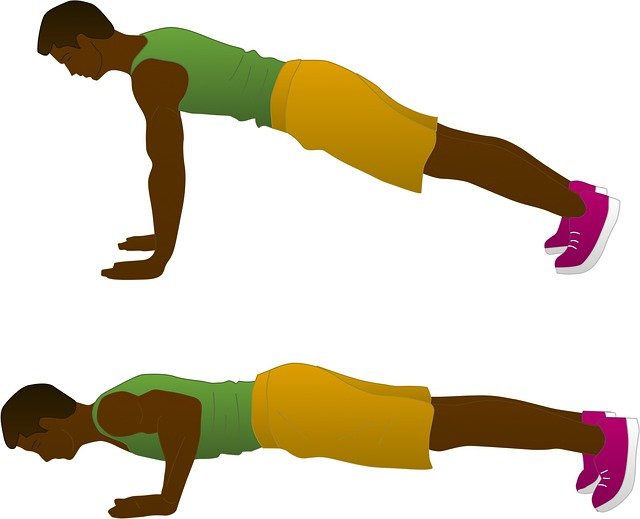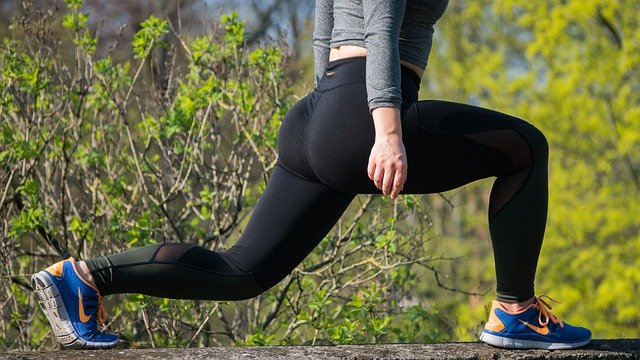
Functional Workouts using bodyweight
You have the tools to workout from home if you can maintain your motivation. A sturdy chair allows you to work the arms as shown in the primary image here where the subject is doing tricep dips. This is a great exercise for all of us, ladies, because this firms and tones the backs of the arms, which reduces that look of “wings.” We often fear that we will bulk up or look like a bodybuilder, but quite frankly, muscles that are well defined and “cut” look far more appealing. We also have to ensure we are balancing the muscle groups with our workout routine, so working the front and the back of the arms is crucial.

Another effective method for working the arms, the chest and the back is with push up exercises. The above illustration is a version of a push up where the tricep muscles are used more intensively. A variation on this is to spread the arms wider, rather than having the arms directly under the shoulders. The wider arm variation allows you to work the back and chest muscles more in the push up position. You can also drop to the knees rather than being on the tips of your toes. This allows for a less intense version that will allow you to build up strength and stamina slowly. Pushups also include the core as you must tighten the abs to stabilize the lower back and protect from injury.

Squats are great for working the lower body. The squat exercise has many variations to ensure we are getting a more complete lower body workout. In the photo, notice how the knees are not going past the toes. This is crucial because it is how we protect our knees from having too much weight and stress placed on the joint area. When the legs are placed in a slightly more open position, where the toes are wider than hip-width apart, this helps to work more of the inner thigh area. Again, we must also tighten the core muscles for stability and protection of the lower back. If you are adding weight to the squats, be sure not to add too heavy of a weight. You can also use your milk containers at home for weights. The gluteals are included in the workout on the way up to neutral or standing.

The above image shows the position of the legs for stretching after our warm up, but this is also referred to as the forward lunge. Depending on the leg you lead with (front leg forward) you are performing a forward lunge. If you lead with putting the leg behind you, then this is a reverse or rear leg lunge. This works the legs, the gluteals (giving you a nice rear view). You are also working the calves here. Abdominals are tight for stability. You can either do a walking lunge, a stationary lunge, and, of course, you can add your weights to make the exercise more difficult in intensity. If you are having balance issues, you can hold on to the counter or you may place one hand on the wall and do the stationary version of this lunge exercise.
The squat can also be performed by putting your back against the wall and slowly lowering your body to a sitting position. This is more of an isometric version of the squat as you are holding the sitting position against the wall for as long as possible. This is another great way to strengthen and tone the legs and we all have walls in the home where we could just hold the squat to strengthen the legs. There are also single leg squat exercises, but these are only recommended for individuals with above average leg strength and exceptional balance. This is not to say that you could not get there, but I think if the objective is toning, then sticking with the standard lunges and squats are enough.
If you have the luxury of using a small gym, you can also include leg press exercises with a leg press workout machine. You can add weights to the squats and lunges when you feel strong enough if you are at the gym, and you can also use step platforms to do step-ups to tone the legs and gluteals. Leg extension machines are also available in the universal machine section of most gyms, but if you are restricted to home workouts, you can use elastic resistance bands to emulate the leg extension. You simply sit on a couch or chair, place one leg slightly forward from the other leg and lift the forward leg until it is extended in front of you. Do not worry if you initially cannot get a full extension. Work up to the full extension over time.
I hope you are finding this information helpful and that you are practicing the information to stay in shape. Being stuck at home doesn’t mean giving up our health and well-being. It simply means we need to be more creative and use other methods of maintaining our fitness. Remember, you also have the outdoors, providing it is not too cold or too hot. Take advantage of the later afternoons for outdoor workouts to avoid excessive heat or to avoid excessive cold.
nákup kamagra online z kanady
koupit levné kamagra bez lékařského předpisu
kamagra v prodeji online
rifaximin without a perscription shipped overnight express
cheapest buy rifaximin generic equivalent
how to order rifaximin buy from canada
purchase xifaxan new zealand buy online
purchase xifaxan price by pharmacy
buying xifaxan uk cheapest
cheapest buy staxyn without a script
buy cheap staxyn australia no prescription
how to buy staxyn price at walmart
how to order avodart usa mastercard
ordering avodart generic drug india
how to buy avodart canada fast shipping
order itraconazole buy virginia
order itraconazole generic cheap
itraconazole cheap price
how to buy fildena no prescription needed
how to order fildena generic available
online order fildena cheap from india
how to order gabapentin australia suppliers
ordering gabapentin generic is it safe
buying gabapentin generic name
get flexeril cyclobenzaprine cheap new zealand
buying flexeril cyclobenzaprine cheap info
canadian pharmacy flexeril cyclobenzaprine online
buy androxal overnight fedex
get androxal generic switzerland
cheap androxal generic equivalent
purchase enclomiphene generic is good
buy cheap enclomiphene united kingdom
buy enclomiphene cost usa
acheter générique kamagra canada
commander kamagra livraison du jour au lendemain
acheter kamagra pharmacie nist prescrire